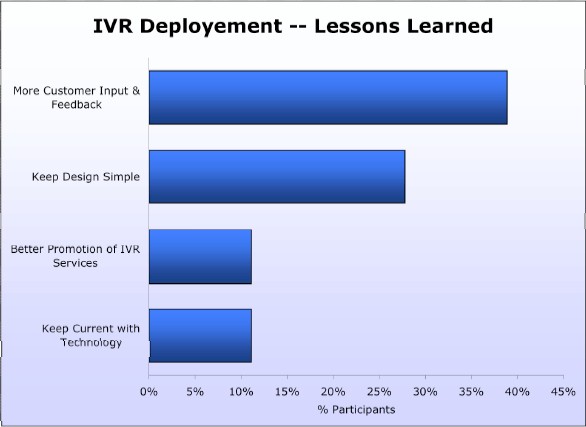|
|


IVR Solutions
This section of our technical library presents information and documentation relating to IVR Development and custom IVR software and products.
Business phone systems and toll free answering systems are very popular for service and sales organizations, allowing customers and prospects to call your organization anywhere in the country.
The PACER and WIZARD IVR System is just one of many DSC call center phone system features..
What is IVR Software?. An Interactive Voice Response (IVR) processes inbound phone calls, plays recorded messages including information extracted from databases and the internet, and potentially routes calls to either inhouse service agents or transfers the caller to an outside extension.
Contact DSC today. to learn more about our IVR services and IVR application development software.
IVR Perceptions
Page 2
By Ascent Group, Inc.
An Extract from IVR Improvement Strategies,
A new research report published by the Ascent Group, Inc.
Benchmark Study of IVR Deployment
To better understand the state-of-IVR, the Ascent Group recently conducted a
benchmarking project to evaluate IVR performance, to understand the never-ending
deployment challenges, and to identify IVR “best practices”. Companies from nine
industries participated in the research. The following pages summarize the study’s
objectives, findings and observations, and recommendations.
The main objective of the study was to evaluate the strategic deployment of interactive
voice response technology and to identify best practices or opportunities for
improvement. Secondary objectives included understanding:
- The range of deployment strategies;
- Primary business objectives and drivers of IVR deployment;
- How IVR technology fits into a customer service strategy, and
- How companies incorporate the customer perspective.
Participants were asked to share the history of their IVR implementation, deployment
and design strategies, performance statistics, best practices, and lessons learned. The
study also asked companies to relate how they measure the success of their IVR
implementation and plans moving forward.

The most frequently cited “lessons learned” was the need to incorporate customer input
and feedback into the design and ongoing management of an IVR system. Companies
are not taking the time or effort to gain knowledge from the customer experience—a
critical mistake that can inflict serious damage to your customer satisfaction ratings, and
ultimately bottom-line revenue.
More than 40 percent of study participants utilize automated speech recognition (ASR),
which further confirms the progress of IVR technology in the marketplace. Another 32
percent have plans to implement speech recognition in the near future. In a similar
study conducted by the Ascent Group in 2000, speech recognition was only prevalent in
less than 10 percent of companies. At that time, most were waiting for the technology to
improve, and it clearly has.
The most popular IVR self-service application was, not surprising, account
inquiry—something that is common to most industries. In fact, many of our participants
indicated the initial IVR deployment strategy was to automate transactions or to control
staffing and costs. Secondly, companies implemented IVR technology to provide
optional or expanded services or to improve customer service interaction with the
company.
In terms of deployment strategy, none of the companies in our study answered the main
customer service line without the assistance of an IVR or ACD prompting menu. While
there were a few specialized lines answered by “live” agents, these were usually limited
to business customers and key accounts.
Half of the IVR deployments “selectively force” callers through the IVR for some
applications—account balances, payment extensions, or outage reporting. What do we
mean by “selectively forcing” callers through the IVR? We mean that callers are not
given a choice between an agent and self-service when selecting these options in the
menu—callers are automatically placed in the IVR application and have to complete the
transaction in the IVR, listen to information, or “opt-out” to speak with a representative.
Forcing callers through IVR applications increases system utilization and success,
especially for callers who are unfamiliar with system options and functions. Selective
forcing encourages higher IVR usage for the more routine tasks while freeing up
representatives to handle the more complex service issues. Selective forcing can also
be dynamically deployed—companies can selectively force callers into IVR applications
during peak calling periods or during off-hours, and still have the flexibility to allow
callers to choose during slower periods.
Several companies have the capability to route a percentage of calls to an outside
vendor’s IVR, transparent to the customer. This option is usually used during heavy call
volume to supplement existing in-house resources. Others have deployed additional
back-up IVR capability in-house to handle peak volume situations.
Appropriate deployment of customer-facing technology is a key determinant of customer
satisfaction. Successful deployment of IVR technology requires extensive research and
design effort to ensure a customer-friendly application that will meet customer needs.
And as we’ve seen in the past, poorly designed systems can do more damage than
good.
Page
[1]
[2]
[3]
[4]
[5]
[6]
[7]
Next Page
|




